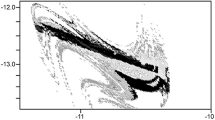Abstract
Learning to predict events in the near future is fundamental to human and artificial agents. Many prediction techniques are unable to learn and predict a stream of relational data online when the environments are unknown, non-stationary, and no prior training examples are available. This paper addresses the online prediction problem by introducing a low complexity learning technique called Situation Learning and several prediction techniques that use the information from Situation Learning to predict the next likely event. The prediction techniques include two variants of a Bayesian inference technique, a variable order Markov model prediction technique and situation matching techniques. We compared their prediction accuracies quantitatively for three domains: a role-playing game, computer network intrusion system alerts, and event prediction of maritime paths in a discrete-event simulator.























Similar content being viewed by others
Explore related subjects
Discover the latest articles, news and stories from top researchers in related subjects.References
Ames M, Chan C, Chng K, Cole A, Johnson D, Kwai K, Koh K, Lim H, Lim T, Liu Y, Marsh A, McRoberts C, Ng C, Ng C, Ng M, Nguyen H, Okruhlik L, Oh P, Ong K, Peh L, Soh W, Tan C, Toh L, Torian J, Wong Y (2007) Port security strategy 2012. M.S. thesis, Naval Postgraduate School, Monterey, California
Buhlmann P, Wyner AJ (1999) Variable length Marov chains. Ann Stat 27(2):480–513
Buss A (2002) Component-based simulation modeling with Simkit. Proceedings of the 2002 Winter Simulation Conference. doi:10.1.1.1.5324
Chen SF, Goodman J (1999) An empirical study of smoothing techniques for language modeling. Comput Speech Lang 13:359–393
Daly R, Shen Q, Aitken S (2011) Learning Bayesian networks: approaches and issues. Knowl Eng Rev 26(2):99–157
Darken C (2005) Towards learned anticipation in complex stochastic environmentss. Proceedings of the Artificial Intelligence for Interactive Digital Entertainment, pp 27–32
Debar H (2000) An introduction to intrusion-detection systems> Proceedings of Connect. doi 10.1.1.101.7433
Frederick E, Rowe N, Wong A (2012) Testing deception tactics in response to cyberattacks. Proceedings of the National Symposium on Moving Target Research, Annapolis. Available at http://cps-vo.org/node/3711
Getoor L, Taskar B (2007) Introduction to statistical relational learning. The MIT Press, Cambridge
Jungkunz P, Darken CJ (2011) A computational model for human eye-movements in military simulations. Comput Math Organ Theory 17(3):229–250
Khosravi H, Bina B (2010) A survey on statistical relational learning. Proceedings of the Canadian Conference on Artificial Intelligence, pp 256–268
Kott A, McEneaney W (2006) Adversarial reasoning: computational approaches to reading the opponent’s mind. Chapman and Hall/CRC, Boca Raton
Kunde D, Darken C (2006) A mental simulation-based decision-making architecture applied to ground combat. Proceedings of the behavior representation in modeling & simulation. doi:10.1.1.64.713
Kurby CA, Zacks JM (2007) Segmentation in the perception and memory of events. Trends Cognit Sci 12(2):72–79. doi:10.1016/j.tics.2007.11.004
László B, Paolo C (2008) Isomorphism of hypergraphs of low rank in moderately exponential time. FOCS ‘08: Proceedings of the 2008 49th Annual IEEE Symposium on Foundations of Computer Science, IEEE Computer Society, pp 667–676, ISBN 978-0-7695-3436-7
Li Z, Zhang A, Lei J, Wang L (2007) Real-time correlation of network security alerts. Proceedings of IEEE International Conference on e-Business Engineering, pp 73–80
McGregor JJ (1982) Backtrack search algorithms and the maximal common subgraph problem. Softw Pract Exp 12:23–34
Qin X (2005) A probabilistic-based framework for INFOSEC alert correlation. Ph.D. dissertation, Georgia Institute of Technology, Atlanta, Georgia
Roesch M (1999) Snort—lightweight intrusion-detection for networks. Proceedings of LISA’99: 13th Systems Administration Conference, pp 229–238
Russell S, Norvig P (2010) Artificial intelligence: a modern approach. Prentice Hall, Upper Saddle River
Sapankevych N, Sankar R (2009) Time-series prediction using support vector machine: a survey. Proc IEEE Comput Intell Mag 4(2):24–38
Sun R, Giles CL (2001) Sequence learning: from recognition and prediction to sequential decision making. IEEE Intell Syst 16(4):67–70
Tan T (2007) Tactical plan generation software for maritime interdiction using conceptual blending theory. M.S. thesis, Naval Postgraduate School, Monterey, California
Author information
Authors and Affiliations
Corresponding author
Rights and permissions
About this article
Cite this article
Tan, T.K., Darken, C.J. Learning and prediction of relational time series. Comput Math Organ Theory 21, 210–241 (2015). https://doi.org/10.1007/s10588-015-9182-0
Published:
Issue Date:
DOI: https://doi.org/10.1007/s10588-015-9182-0




